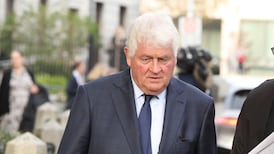The judge in the trial of murder-accused Graham Dwyer has said a reference he gave the jury during his charge to them was "incorrect".
Mr Justice Tony Hunt said an assertion he had made in relation to circumstantial evidence having the capacity to prove a case to a mathematical degree was "incorrect".
“Circumstantial evidence can of course prove things beyond reasonable doubt, but mathematical accuracy doesn’t come into it,” he said.
“It’s not a required standard and it’s not a reasonable standard.”
Mr Dwyer (42), an architect from Kerrymount Close in Foxrock, is charged with murdering childcare worker Elaine O’Hara (36) on August 22nd, 2012. He has pleaded not guilty. Elaine O’ Hara’s remains were found in forestry on Killakee Mountain, Rathfarnham, on September 13th, 2013.
Yesterday morning, Mr Justice Hunt recalled the jury, having sent them out to begin their deliberations at 3.30pm on Tuesday afternoon.
‘Nasty surprise’
“I have a nasty surprise for you,” he told them.
He reminded them he had said on Monday he expected to let them retire on Tuesday afternoon.
“I did, but at the price of shifting up the gears too quickly,” he said. There were a couple of things he needed to deal with in more detail, the judge told them.
It “would have been nice” to have done it in the time he had, he said, but it would “rest easier” in his mind if he completed his remarks in the manner he wanted.
“I think it’s an example of taking a short cut – but when is a short cut not a short cut?” he asked.
He also said if he commented or pointed out areas, that was simply his take on it. “I made comment, you can put it to one side and bin it,” he said.
Mr Justice Hunt read into the record the evidence of consultant psychiatrist Dr Matt Murphy, who took the stand on February 12th.
Ms O’Hara was his patient at St Edmundsbury’s psychiatric unit in Lucan from the end of 2007 and, in evidence, the psychiatrist detailed her medical history and her condition on discharge from hospital on the day she disappeared. He had said he believed she was making progress and she had no indication of suicidality.
He had also said he would have been surprised and disappointed if Ms O’Hara had felt suicidal and had not turned to the hospital for help.
Mr Justice Hunt said he was sorry he hadn’t read the evidence to the jury in full on Tuesday; he intended to, but in trying to move things on he did not.
He told the jury Dr Murphy had the expertise in suicidality. The defence and prosecution and he had their theories, but Dr Murphy’s theories “may be ultimately more important” .
He also pointed out to the jury that the presence or absence of blood, including where Ms O’Hara’s body was found, was important “depending on the level of expectation”. He said it could be dependent on the effects of weather and time.
Marks
Mr Justice Hunt also revisited the question of whether marks would be left on a skeleton after a knife attack.
He told them the prosecution relied on all documents in relation to how Ms O'Hara was killed. These not only included Killing Darci, a graphic story of frenzied stabbing and rape found on Mr Dwyer's hard drive, but also text messages closer in time to Ms O'Hara's disappearance.
He highlighted the text “you are going to get stabbed in the guts”, a text sent to Ms O’Hara on August 21st, 2012.
He also pointed out the evidence of body tissue found on Ms O’Hara’s tracksuit bottoms, and the fact that they were found inside out.
The judge recapped on the prosecution and defence closing. Sean Guerin SC, for the prosecution, maintained suicidality was there for Ms O’Hara, but was not present at the time and the “factual matrix doesn’t support it”, Mr Justice Hunt said.
He said Remy Farrell SC, for the defence, dwelt on the “dichotomy of fantasy and reality” and said the death was a better fit with self-harm.
“He wasn’t specific about what means of self-harm,” said the judge.
He also commented on a text message allegedly sent by Mr Dwyer on the day Ms O’Hara disappeared , telling her to take a painkiller at 5pm.
“It’s an odd text to send to somebody . . . oddness and this case seem to go hand in hand, there is no doubt about that,” he said.
He told the jury there were only two verdicts to consider: guilty of murder or not guilty of murder. They were not being asked to consider any intermediate offence.
“It is very stark,” he said. “Accidental death is out of the picture.”
The jury will continue deliberations on Thursday.












